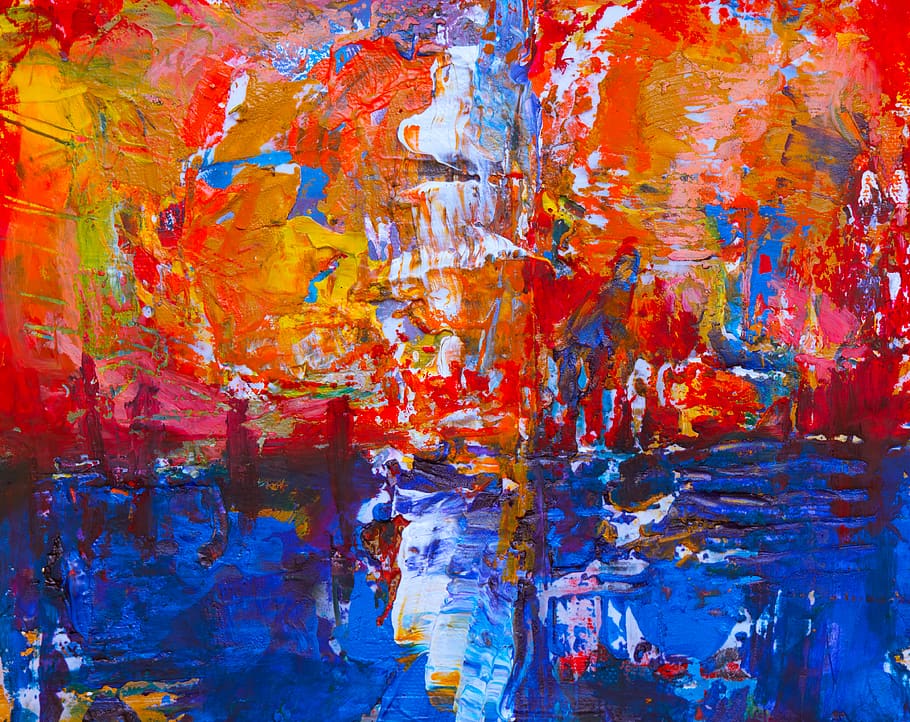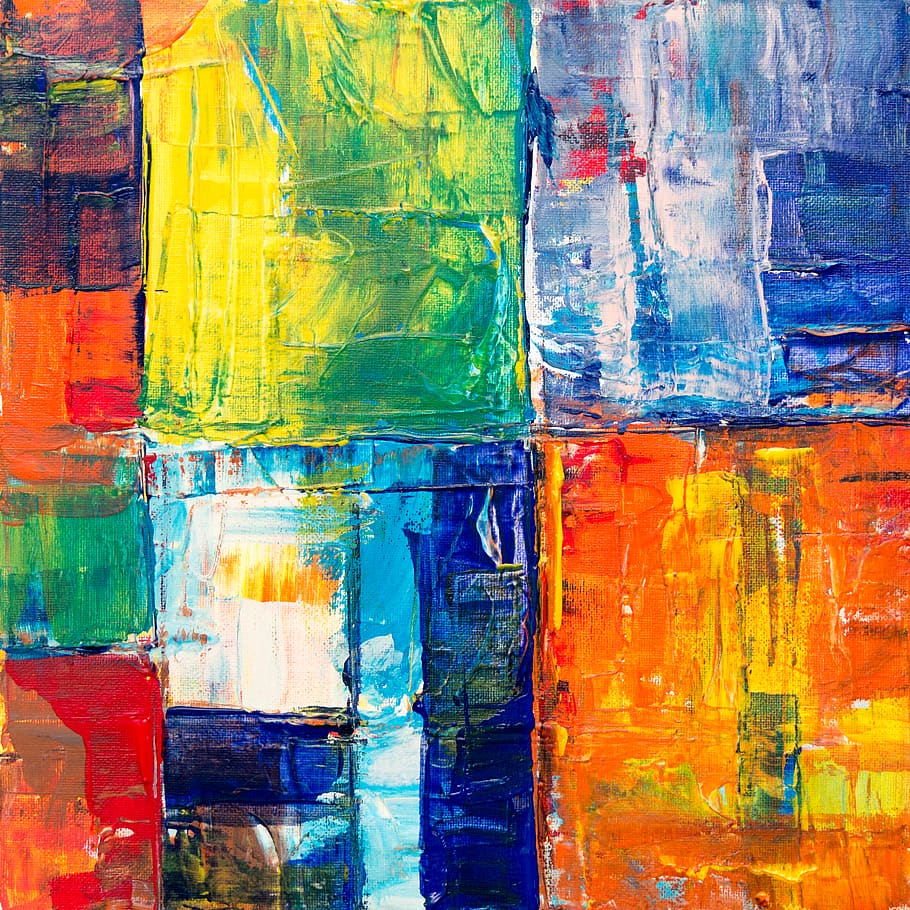Abstract expressionism is an art movement, a new style of painting that emerged in the 1940s and 1950s in America.
Abstract expressionism was a radical departure from traditional painting. Instead of depicting realistic scenes, it captured the viewer’s attention with abstract shapes and colors.
What Is Abstract Expressionism
What Is Abstract Expressionism?
Abstract Expressionism is a small group of artists who used abstract painting to express their feelings and experiences.
They painted in the 1950s in New York City, although some of the best-known artists were from California. Their paintings were abstract, but they also drew on American traditions.
Abstract Expressionism was an important movement in art history because it brought together several different ideas about painting. It began with a lot of experimentation with color, shape and texture.
The artists wanted to make their paintings look spontaneous and emotional rather than carefully planned out like traditional oil painting.
Abstract Expressionism isn’t just an art movement; it’s a visual language that communicates the raw, unfiltered emotions of the artist.
It emerged in the 1940s and 50s, sweeping through the art world like a storm, with its bold colors and dynamic brushstrokes.
In this article, we’ll jump into the essence of Abstract Expressionism, exploring its key characteristics and influential figures.
We’ll uncover why it’s considered the first major American movement to gain international influence and how it’s still resonating in the art community today.
Origins Of Abstract Expressionism
The gestation of Abstract Expressionism can be traced back to the early 20th century when avant-garde artists in Europe began pushing the boundaries of traditional art forms.
American artists caught the wave of this radical shift during the 1930s and 40s, catalyzing what would become a significant movement.
It’s crucial to acknowledge that this style didn’t emerge in a vacuum – numerous factors contributed to its birth:
- The Great Depression and the New Deal’s funding for art projects,
- The influx of European artists fleeing World War II,
- The exposure to surrealism and psychoanalytic theory.
These elements set the stage for a distinctive American art movement characterized by a fierce independence and a new visual language.
By the mid-1940s, Abstract Expressionism began taking a more definitive shape in New York.
Galleries and salons were buzzing with artists who sought to articulate their individual experience through powerful and spontaneous works.
Jackson Pollock‘s drip paintings and Willem de Kooning‘s aggressive palette knife applications were among the bold techniques that defined the movement’s directness and scale.
This crop of artists didn’t just use the canvas – they attacked it, wrestled with it, and infused it with their emotions.
Cultural institutions like the Museum of Modern Art played a crucial role in cementing the movement’s reputation.
Exhibitions such as The New American Painting not only introduced Abstract Expressionism to the European audience but also solidified its critical reputation back home.
With the media’s help, Abstract Expressionism became synonymous with the innovative and uncompromising spirit of post-war America, shaping the discourse around contemporary art for years to come.
Characteristics Of Abstract Expressionism
Abstract Expressionism is known for its unique and dynamic visual language.
In exploring this art form, we’re struck by several key characteristics that set it apart from other movements.
- Freedom of Technique – Artists embraced a diverse range of techniques and were recognized for their innovation and lack of conformity to traditional methods.
- Emphasis on Spontaneity – This movement encouraged spontaneous, often aggressive applications of paint and unconventional tools. At the core of Abstract Expressionism stands the idea that art should not represent reality but rather the intense emotions and expressions of the artist. The canvas served as an arena to act out these emotions, with artists often using large scale formats and emphasizing the physical act of painting.
- Large-scale Works – Canvases were vast, providing an immersive experience for the viewer.
- Non-representational Imagery – The artwork typically did not depict objects or scenes from the natural world.
Icons like Jackson Pollock explored drip painting, where the process of making the art was just as important as the final piece itself.

Pollock’s technique is a testament to the movement’s investment in authenticity and individual expression.
- action painting – Artists expressed their unconscious through physical action, with energetic gestures that were sometimes violent and always impulsive. Other Abstract Expressionists, such as Mark Rothko, focused on color field painting, characterized by large areas of a single color or simple, soft-edged geometric structures. Rothko’s work evokes a contemplative experience, aiming to envelop the viewer in a mood.
- Color Field Painting – Artists such as Rothko used expansive areas of color to evoke contemplative responses from the audience. Besides, the movement was not just about the finished artwork but about the process of creation. Insights derived from surrealism and psychoanalysis informed artists’ work and their approach to the canvas. This psychological depth coupled with their groundbreaking styles fostered a new era of modern art.
Key Figures Of Abstract Expressionism
When exploring the monumental movement that swept through the art world during the mid-20th century, we can’t overlook the influential artists that championed Abstract Expressionism.
Their diverse backgrounds and unique approaches to art left an indelible mark on the canvas of history.
First, let’s consider Jackson Pollock, often hailed as the poster child of the movement.
Pollock’s radical drip painting techniques, where rhythm and motion prevailed over traditional brushwork, resulted in masterpieces like Autumn Rhythm and Blue Poles.
His method – flinging, pouring, and splattering paint – encouraged viewers to consider the act of painting as part of the art itself.
Next up is Willem de Kooning, whose aggressive brushwork and distorted figures provide a contrasting narrative to Pollock’s abstract landscapes.
De Kooning’s commitment to the human form, particularly in his renowned series Woman, adds a tangible aspect to the otherwise ethereal realm of Abstract Expressionism.
Mark Rothko, another central figure, takes a different approach with his sublime color field paintings.
Rothko’s expansive works, such as Orange and Yellow and No.

14, engage viewers with their vast blocks of color that seem to pulsate with emotion, reflecting his desire to evoke profound spiritual responses.
- Jackson Pollock – Drip Painting Pioneer * Autumn Rhythm * Blue Poles,
- Willem de Kooning – Human Form in Abstraction * Woman Series,
- Mark Rothko – Master of Color Field * Orange and Yellow * No. 14.
In their own unique ways, these artists pushed the boundaries of what art could represent, focusing on the dynamic process of creation and the emotional capacity of their work.
Their influence continues to permeate through various art forms, including filmmaking, where abstraction and expressionist techniques can be employed to evoke deep psychological reactions and storytelling without relying solely on narrative structure.
Impact Of Abstract Expressionism
The ripples of Abstract Expressionism have permeated various artistic disciplines, significantly shaping the creative landscape.
This art movement, famed for its raw, impromptu methods and profound emotive appeal, has left an undeniable mark.
In the realm of visual arts, the influence is most palpable.
Artists across the world drew inspiration from the movement’s lack of constraints, experimenting with bold new techniques and ideas.
Galleries and museums frequently exhibit works that owe a great deal to Abstract Expressionist principles.
- Influence on Modern Art – Embracing chaos and personal expression, later art movements such as Neo-Expressionism and Street Art echo the foundational themes of Abstract Expressionism.
Turning to cinema, the Abstract Expressionist ethos has led filmmakers to embrace more expressive, non-linear storytelling.
Films that channel the spirit of Pollock or Rothko do so through visual abstraction – they create mood and tone not just from narrative but through cinematography and editing styles.

- Elements in Film – Color, light, and framing choices.
- Narrative Techniques – Non-linear, fragmented, or stream-of-consciousness storytelling.
The commercial sector also cannot be overlooked.
From the design of sleek ads to the impactful environments in video games, the influence of Abstract Expressionism is seen in the evocative imagery that seeks to elicit an immediate emotional response.
also, the digital age has furnished a new canvas for Abstract Expressionist techniques.
With sophisticated software at their disposal, digital artists and animators are crafting experiences that parallel the dynamism and spontaneity of their mid-20th-century forebears.
This digital revolution has brought Abstract Expressionism into a new era, maintaining the legacy of its powerful aesthetic.
Abstract Expressionism Today
When we jump into today’s art scene, Abstract Expressionism still resonates with creatives and audiences alike.
Contemporary artists draw inspiration from this movement, concocting works that speak with similar emotional depth and spontaneity.
The principles of Abstract Expressionism ripple through various modern mediums – from large-scale installations to digital art platforms.
Modern filmmakers, too, incorporate Abstract Expressionist techniques into their narrative and visual styles.
Directors like Lynne Ramsay and Terrence Malick create cinematic experiences that are often more about visceral impact than linear storytelling.
Their films embody a sensory-driven approach that parallels the emotive expressions found in Abstract Expressionist paintings like Jackson Pollock’s Autumn Rhythm or Willem de Kooning’s Woman I.
The digital realm has opened up new avenues for Abstract Expressionist influence:
- Virtual reality experiences that engage viewers in a full-bodied artistic encounter,
- Graphical abstract animations that evoke the dynamism of gestural brushstrokes – Interactive installations where audience movements influence the art in real-time Such innovations show that the essence of Abstract Expressionism – the desire to transcend the conventional and to evoke raw, authentic reactions – is alive and thriving, creating a legacy that continues to shape the horizon of the creative arts.
What Is Abstract Expressionism In Art – Wrap Up
We’ve seen the indelible mark Abstract Expressionism has left on the artistic world.
It’s clear that its influence extends far beyond the canvas, inspiring a broad spectrum of creators across various mediums.
From the tactile brushstrokes on a painter’s canvas to the immersive digital landscapes of virtual reality, the spirit of this movement continues to pulse through contemporary art.
As we embrace these evolving forms of expression, we’re reminded of the power of art to communicate the depths of human emotion and the boundless possibilities that lie within the abstract.
Frequently Asked Questions
What Is Abstract Expressionism?
Abstract Expressionism is an art movement characterized by spontaneous, abstract forms and emotional depth.
It emerged in the 1940s and 1950s, primarily in New York, challenging traditional art by focusing on non-representational improvisation.
How Does Abstract Expressionism Influence Contemporary Art?
Contemporary artists often embrace the Abstract Expressionist spirit by creating artworks that prioritize emotional intensity and spontaneity.
This influence appears in various artistic disciplines, reflecting the movement’s enduring relevance.
In What Ways Has Abstract Expressionism Impacted Cinema?

Filmmakers incorporate Abstract Expressionist methods by emphasizing visual storytelling with a visceral impact.
This can result in non-linear narratives and a focus on mood and atmosphere, mirroring the movement’s abstract dynamics.
How Has The Digital Realm Been Affected By Abstract Expressionism?
The digital realm hosts new forms of Abstract Expressionist-inspired creativity, such as virtual reality, graphical animations, and interactive installations.
These mediums leverage technology to express the movement’s core tenets of emotional authenticity and innovation.
Does Abstract Expressionism Still Have Relevance In Today’s Creative Arts?
Yes, Abstract Expressionism remains influential in today’s creative arts.
Its essence—transcending the conventional to elicit genuine, instinctive responses—is continually reshaped and adapted within modern artistic expressions across various disciplines.


